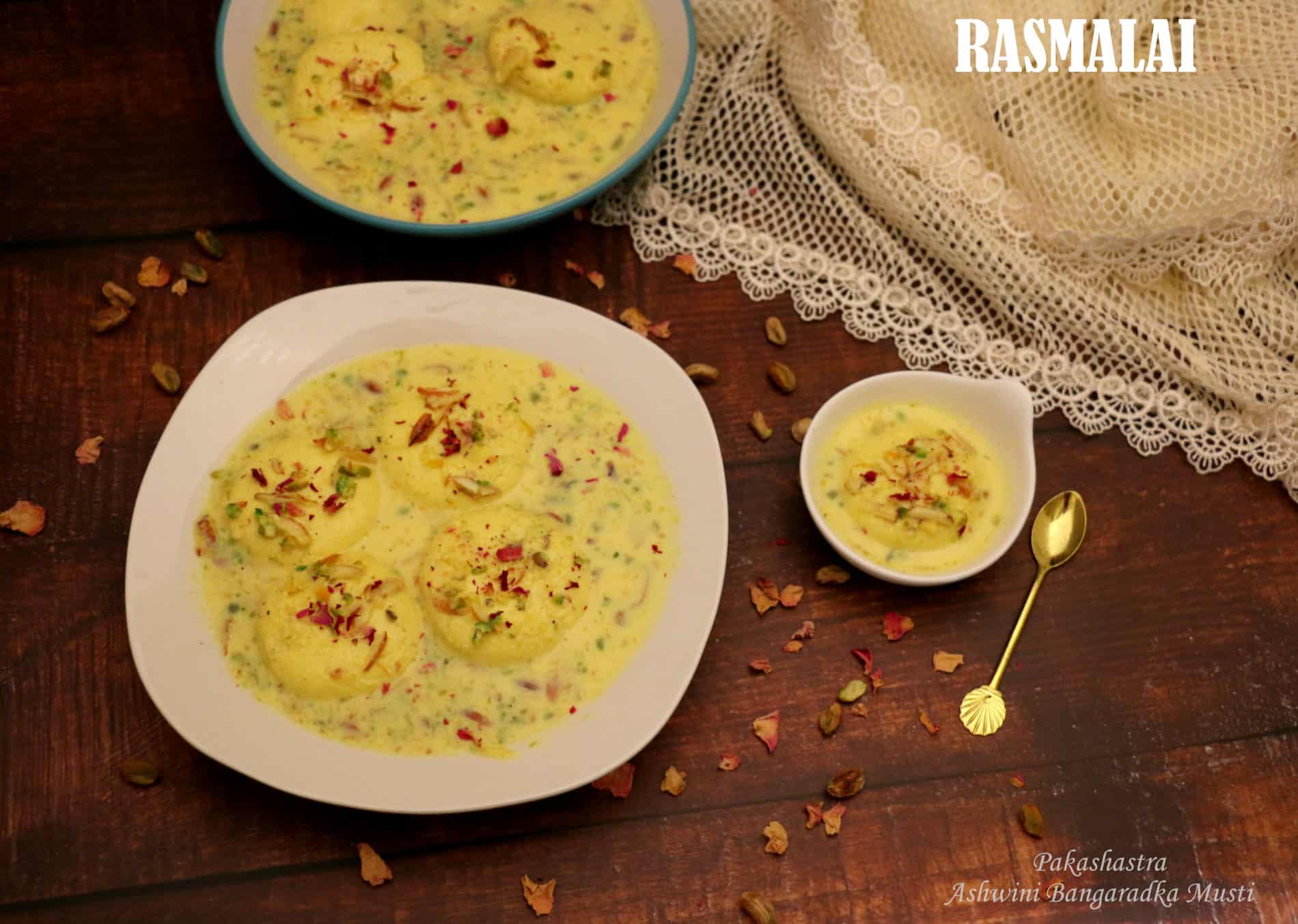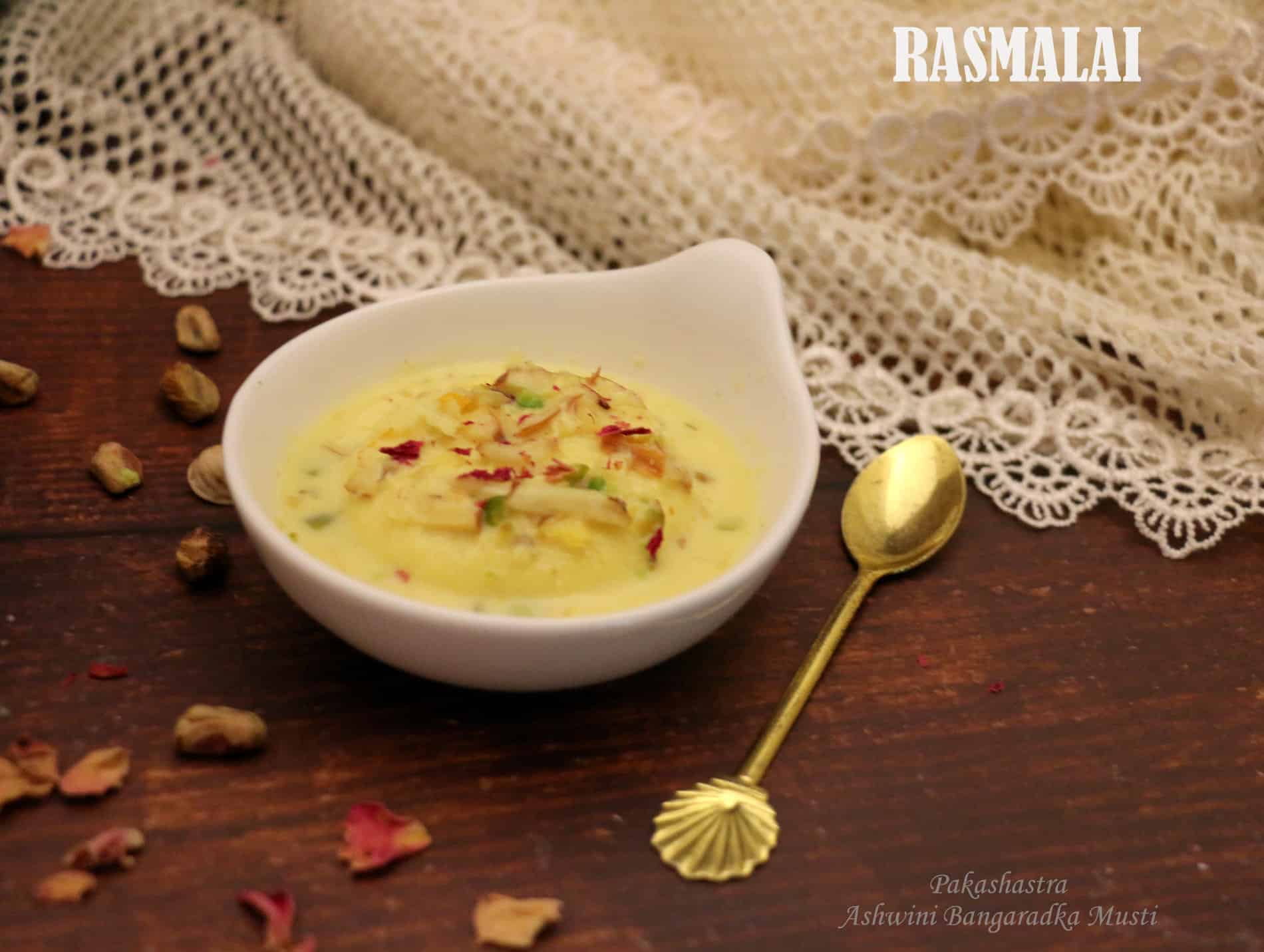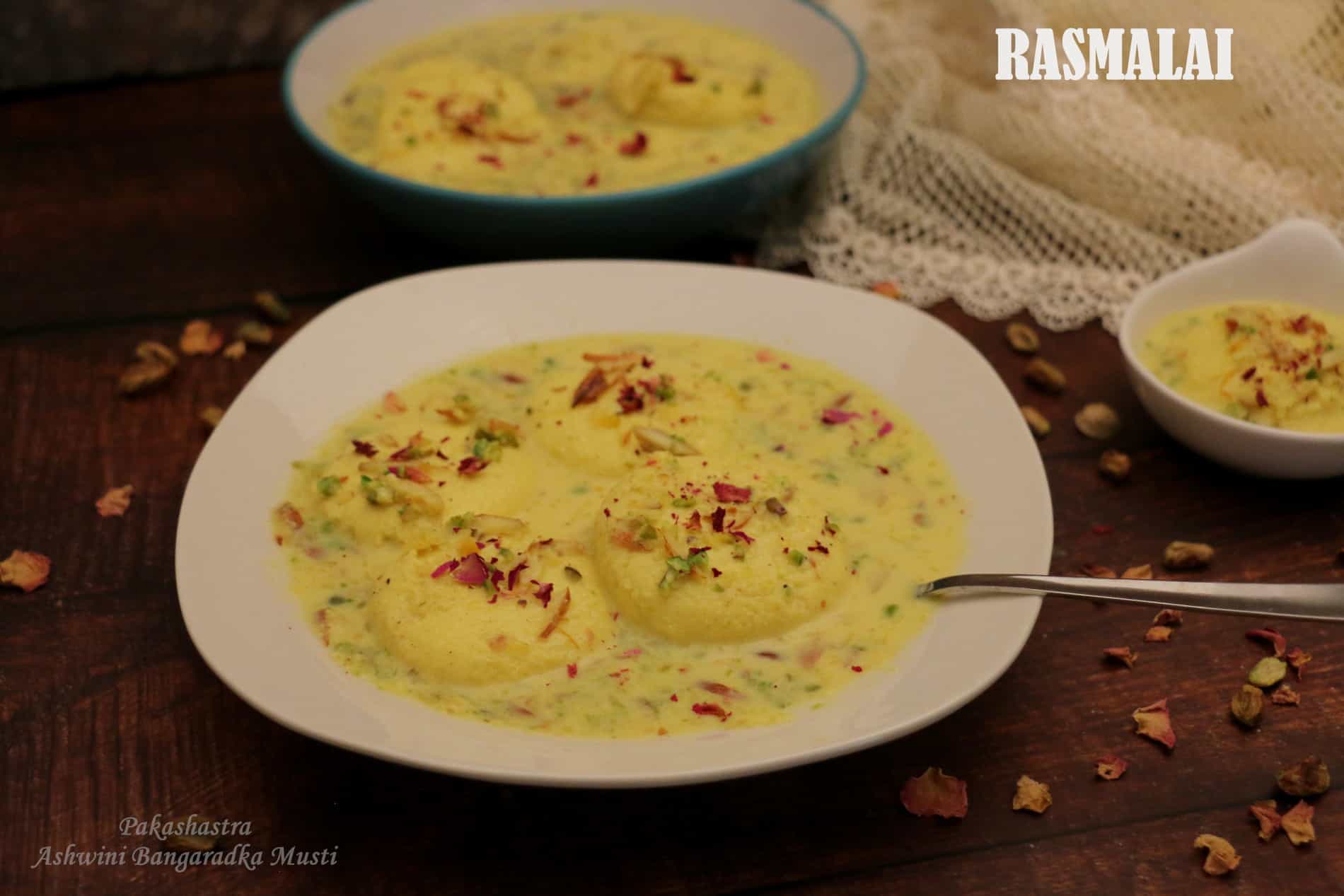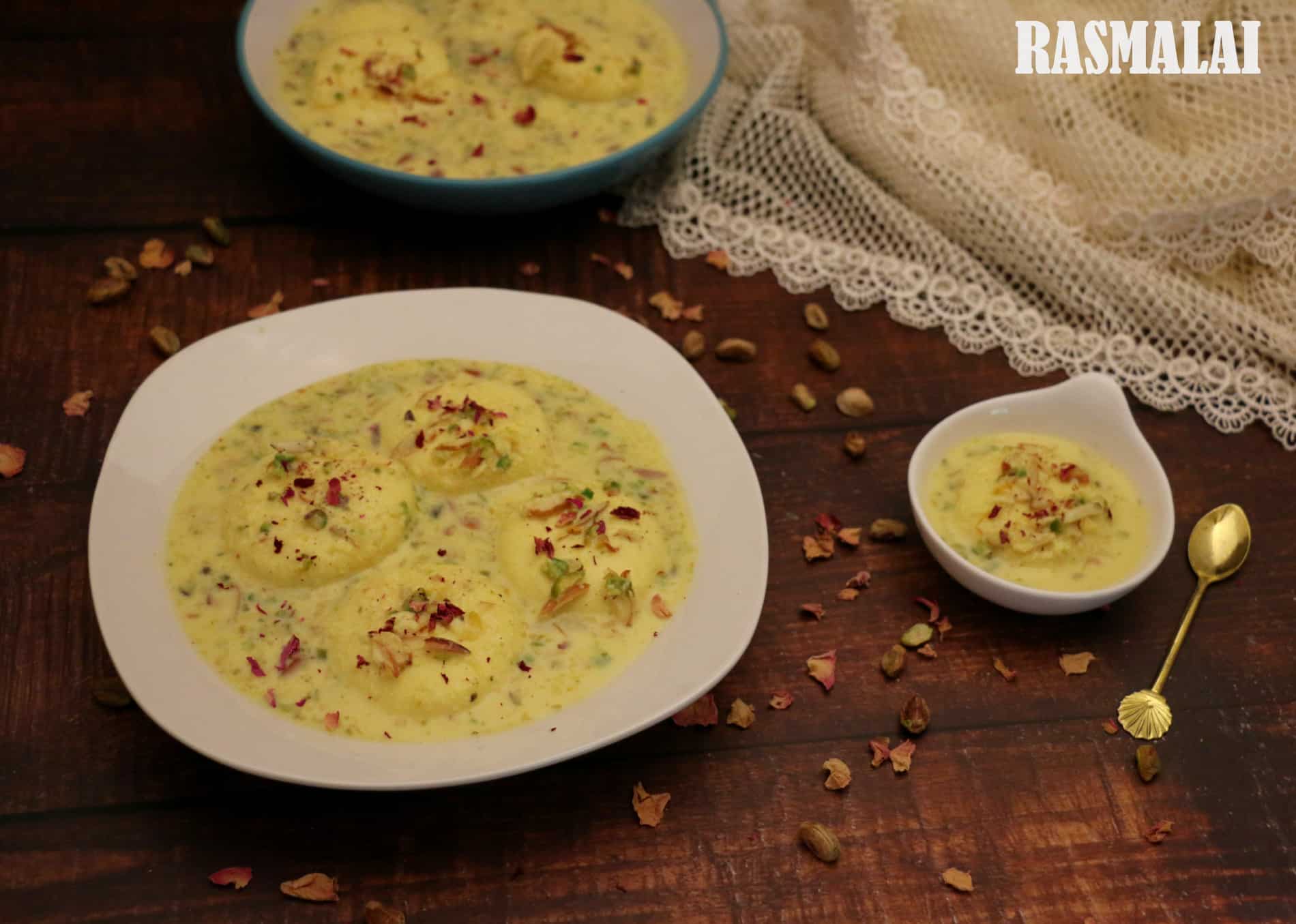Rasmalai is a famous Indian dessert from Bengal, known to be invented by KC Das. Known as Rossomalai in Bengal, it is prepared using small, soft and spongy discs of freshly made cottage cheese called as chenna. These discs are cooked in sugar syrup and then soaked in chilled and slightly thickened flavored milk. This delicious dessert is slightly tricky to make but once you get the knack of it, it is a breeze to make.

HOW IS RASMALAI MADE?
To make Rasmalai, you first need to make Rasgulla or Rosogulla. Typically, Rasgulla is round in shape while Rasmalai is flattened to a disc shape. Here is my recipe to make Rasgulla.
To prepare Rasmalai, first boil milk and curdle it using an acidic ingredient like Lemon juice or vinegar. The curdled milk is then strained to remove all the moisture yielding cottage cheese, also known as chenna in India. This chenna is kneaded thoroughly with the heal of your palm until smooth. Small patties or discs are made and cooked in thin sugar syrup. The cooked chenna discs known as Rasgulla, are then soaked in milk that is flavored with saffron, cardamom, sugar and lots of slivered almonds and pistachios. It is set to chill for at least 4-5 hours and then served. Rasmalai is now ready
Ras in Rasmalai means the flavored milk and Malai means cream and here the milk solid disc or Rasgulla.

HOW SHOULD PERFECT RASMALAI BE?
Making perfect melt-in-mouth Rasmalai may be a little tricky for beginners. But once you get the knack of it or follow the tips, it is easy to prepare.
A perfect Rasmalai should:
Making perfect melt-in-mouth Rasmalai may be a little tricky for beginners. But once you get the knack of it or follow the tips, it is easy to prepare.
A perfect Rasmalai should:
- Hold perfect disc shape or round (if you prefer) and not disintegrate in the syrup.
- Be soft, smooth, spongy and melt in mouth.
- Absorb flavored milk and be juicy inside.
- Be mildly sweet

KEY POINTERS TO MAKE PERFECT RASMALAI:
- Use Cow’s milk. Buffalo milk is suitable as it has too much fat.
- Boil the milk right and cool it for a few minutes to get perfectly curdled chenna.
- Right quantity of acidic ingredient must be used to curdle the milk.
- Chenna must be rinsed in cold water to keep it soft and remove the taste and flavor of acidic ingredient used.
- Chenna must be kneaded well until it is soft, silky and pliable.
- The sugar syrup must be thin and boiling while you dunk the chenna discs.
- Only pure white sugar must be used. You can use Palm jaggery instead.
- While boiling sugar, remove any scum formed on top.
- Once you dunk the chenna discs, boil it on high flame and they should double in size.
- The Ras i.e., the flavored milk should not be too thick. If it is too thick, it will not be absorbed by the chenna discs/Rasgullas.
- Once the chenna discs/Rasgullas are dunked in flavored milk, set aside for at least 4-5 hours and serve them chilled.
Read the NOTES below and follow every instruction described.

Notes:
- The texture of chenna discs or Rasgulla in Rasmalai is greatly dependent on the type of milk you use. Use only cow’s milk; whole milk. Extremely low-fat milk will not work either. Buffalo milk is a no-no as it is too high in fat.
- Turn off the milk once it comes to a boil. Let it cool down for 4-5 minutes before adding an acidic ingredient to curdle.
- Use vinegar or lime juice as the acidic ingredient. Diluting it with equal quantity of water before adding to milk, helps in getting soft and spongy chenna discs/Rasgulla.
- The quantity of acidic ingredient needed may vary slightly depending on the quality of milk. When the milk curdles, there should be a clear, yellowish-greenish water that separates. This water is called Whey and is very nutritious. Reserve whey to use in kneading in roti dough, preparing soups, sambhar, rasam or dal.
- Drain the curdled milk/chenna using a muslin cloth until all the water is drained out. The chenna must be soft and have very little to no moisture but not as dry as paneer. If it is too dry or if there is too much moisture, the chenna discs will disintegrate in sugar syrup while cooking.
- It is very important to knead the paneer using the heal of your palm to break the grainy crumbs down until they are soft, smooth and pliable. Knead until you see some grease on the heal of your palm. You may pulse it in a blender for a couple of times, I have not tried this method.
- Using a little cornstarch or arrowroot powder or all-purpose flour helps in binding the chenna.
- Prepare sugar syrup in a large pot as the chenna discs will swell up and double in size. So use a pot with enough room to avoid over-crowding the discs.
- Sugar syrup should be thin and come to rolling boil when dunking the chenna discs. Keep the pot covered, preferably with a glass lid so that you can watch the disc growing in size. Any other lid also will do. Cook on high flame.
- Traditionally, the milk in which the chenna discs/Rasgullas are soaked are flavored with cardamom and saffron. However, you can try variations like rose milk, etc.,
- Be gentle when you squeeze the syrup out of the chenna disc/Rasgulla. If you press too hard, them might break apart.
- The flavored milk must be boiled well until it reduces to nearly 1/2 the original volume. Do not reduce it further. If the milk is too thick, the chenna discs/Rasgullas will not absorb the milk properly. Use whole milk and not the low-fat milk.

[penci_recipe]
